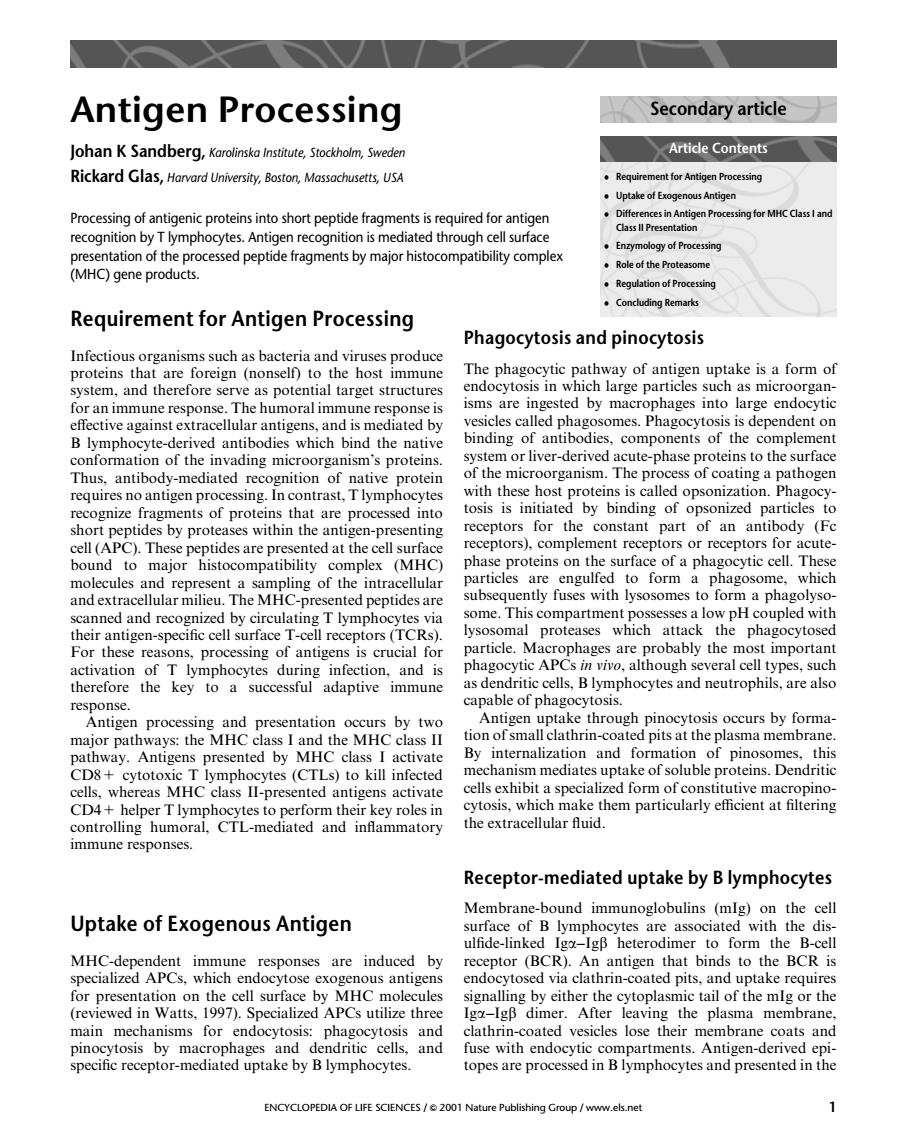正在加载图片...

Antigen Processing Secondary article ohan K Sandberg,Karolinska Stockholm,Sweder Artice Contents Rickard Glas.Harvard University.Boston.Massochusetts.USA nent for Antioen Processin .Uptake of Exogenous Antigen cessing for MHC Class I an ytes.Antigen pCgnaan2hepoceedpepetiegmentbymajprhitocompatbi时ycomplex ition is ough cell surface mology of Processinc 。Role of the Pro (MHC)gene products. n of Processin Concluding Remark Requirement for Antigen Processing Phagocytosis and pinocytosis duc system.and therefore serve as potential target structures The phagocytic pathway of antigen uptake is a formo ted h binding of antibodies,components of the complement of the invading mieroorgnim's rotein cute-phase proteins to the surfac Thus,antibody-mediated recognition of native protein requires no antigen processing.In contrast,T lymphocytes are proces receptors for the constant part of an antibody (Fe )These ptides are nted at the cell surfac eceptors). omplement receptors o: bound to major histocompatibility complex (MHC) a phagocytic ce subsequently fuses with lysoso omes to form a nhagolyso and extra (TCRs) For these reasons,processing of antigens is crucial for lymphocytes audapUe0,and capable of phagocytosis. Antigen processing and pre sentation occurs by twe Antigen ays:the MHC class I and the MHC class II uptake through pinocy m maior pathy the pathway.An gens prese nted by MHC clas (CI cells exhibit a specialized form of constitutive macropino CD4+helper Tly rform their key roles in controlling humoral.CTL-mediated and inflammatory extrace immune responses. Receptor-mediated uptake by B lymphocytes Membrane-bound immunoglobulins (mIg)on the cell Uptake of Exogenous Antigen surface of B lymphocytes are associated with the dis. ulfide-linked Igx-IgB heterodimer to form the B-cell responses are induced by (CR).that binds the BCR is -001 (reviewed in Watts 1997)Specialized APCs utii thrce -Igp dimer.Afer leaving the plasma membrane. main mechanisms for endocytosis:phagocytosis and lathrin-coated vesicles lose their membrane coats and endntic cells,and spec receptor-m opes are processe ENCYCLOPEDIA OF LIFE SCIENCES/2001 Nature Publishing Group/www.els.net Antigen Processing Johan K Sandberg, Karolinska Institute, Stockholm, Sweden Rickard Glas, Harvard University, Boston, Massachusetts, USA Processing of antigenic proteins into short peptide fragments is required for antigen recognition by T lymphocytes. Antigen recognition is mediated through cell surface presentation of the processed peptide fragments by major histocompatibility complex (MHC) gene products. Requirement for Antigen Processing Infectious organisms such as bacteria and viruses produce proteins that are foreign (nonself) to the host immune system, and therefore serve as potential target structures for an immune response. The humoral immune response is effective against extracellular antigens, and is mediated by B lymphocyte-derived antibodies which bind the native conformation of the invading microorganism’s proteins. Thus, antibody-mediated recognition of native protein requires no antigen processing. In contrast, T lymphocytes recognize fragments of proteins that are processed into short peptides by proteases within the antigen-presenting cell (APC). These peptides are presented at the cell surface bound to major histocompatibility complex (MHC) molecules and represent a sampling of the intracellular and extracellular milieu. The MHC-presented peptides are scanned and recognized by circulating T lymphocytes via their antigen-specific cell surface T-cell receptors (TCRs). For these reasons, processing of antigens is crucial for activation of T lymphocytes during infection, and is therefore the key to a successful adaptive immune response. Antigen processing and presentation occurs by two major pathways: the MHC class I and the MHC class II pathway. Antigens presented by MHC class I activate CD8+ cytotoxic T lymphocytes (CTLs) to kill infected cells, whereas MHC class II-presented antigens activate CD4+ helper T lymphocytes to perform their key roles in controlling humoral, CTL-mediated and inflammatory immune responses. Uptake of Exogenous Antigen MHC-dependent immune responses are induced by specialized APCs, which endocytose exogenous antigens for presentation on the cell surface by MHC molecules (reviewed in Watts, 1997). Specialized APCs utilize three main mechanisms for endocytosis: phagocytosis and pinocytosis by macrophages and dendritic cells, and specific receptor-mediated uptake by B lymphocytes. Phagocytosis and pinocytosis The phagocytic pathway of antigen uptake is a form of endocytosis in which large particles such as microorganisms are ingested by macrophages into large endocytic vesicles called phagosomes. Phagocytosis is dependent on binding of antibodies, components of the complement system or liver-derived acute-phase proteins to the surface of the microorganism. The process of coating a pathogen with these host proteins is called opsonization. Phagocytosis is initiated by binding of opsonized particles to receptors for the constant part of an antibody (Fc receptors), complement receptors or receptors for acutephase proteins on the surface of a phagocytic cell. These particles are engulfed to form a phagosome, which subsequently fuses with lysosomes to form a phagolysosome. This compartment possesses a low pH coupled with lysosomal proteases which attack the phagocytosed particle. Macrophages are probably the most important phagocytic APCs in vivo, although several cell types, such as dendritic cells, B lymphocytes and neutrophils, are also capable of phagocytosis. Antigen uptake through pinocytosis occurs by formation of small clathrin-coated pits at the plasma membrane. By internalization and formation of pinosomes, this mechanism mediates uptake of soluble proteins. Dendritic cells exhibit a specialized form of constitutive macropinocytosis, which make them particularly efficient at filtering the extracellular fluid. Receptor-mediated uptake by B lymphocytes Membrane-bound immunoglobulins (mIg) on the cell surface of B lymphocytes are associated with the disulfide-linked Iga–Igb heterodimer to form the B-cell receptor (BCR). An antigen that binds to the BCR is endocytosed via clathrin-coated pits, and uptake requires signalling by either the cytoplasmic tail of the mIg or the Iga–Igb dimer. After leaving the plasma membrane, clathrin-coated vesicles lose their membrane coats and fuse with endocytic compartments. Antigen-derived epitopes are processed in B lymphocytes and presented in the Article Contents Secondary article . Requirement for Antigen Processing . Uptake of Exogenous Antigen . Differences in Antigen Processing for MHC Class I and Class II Presentation . Enzymology of Processing . Role of the Proteasome . Regulation of Processing . Concluding Remarks ENCYCLOPEDIA OF LIFE SCIENCES / & 2001 Nature Publishing Group / www.els.net 1